| Article ID | Journal | Published Year | Pages | File Type |
|---|---|---|---|---|
| 5498962 | Radiation Measurements | 2017 | 24 Pages |
Abstract
Optically stimulated luminescence (OSL) was first observed from natural quartz 30 years ago. Since it increases with exposure to radiation, OSL has been developed as a dating tool for sediments. Most commonly, the OSL signal is observed using optical filters that pass wavelengths centred on 340Â nm during optical stimulation at 470Â nm. Experimental evidence behind the choice of measurement conditions for dating is presented, for example, information on the emission spectra. Different methods of optical stimulation are reviewed, including non-linear application of stimulation power; these are related to isolation of the fast OSL component that is most appropriate for dating sediments. Practical methods for fast OSL component separation are mentioned. Information on the stimulation process has been obtained by varying the wavelength during measurement and by varying the stimulation temperature. On the other hand, information on the recombination process is provided by observing the OSL emitted when the stimulation source is pulsed; this has practical applications when feldspar contamination is expected. Although laboratory experiments imply more than adequate thermal stability of the fast OSL signal for dating back to a million years, ages determined in the laboratory using the single aliquot regenerative dose procedure do not agree with independent ages. To address this problem, luminescence signals derived from the same electron trap, as well as those resulting from stimulation in the infrared (875Â nm) and in the violet (405Â nm), have been investigated as potential dating tools.
Related Topics
Physical Sciences and Engineering
Physics and Astronomy
Radiation
Authors
A.G. Wintle, G. Adamiec,
